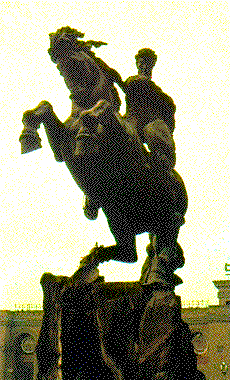A Brief History of the University in Armenia
In learning of Armenia's past and present, you will surely come to see the devotion with which Armenians regard education and
culture. Yerevan State University is the symbol of the educational system of the newly-independent Republic of Armenia. Its roots go
back to the millennia-old history of Armenian education and culture.
In pagan Armenia, schools were created and operated under temples. Their graduates usually became pagan priests.
In 301, Christianity was declared the state religion. It would play an important role in the future development of Armenian culture. At
the beginning of the Fifth Century in 405-406 AD, Mesrop Mashtots created the Armenian alphabet. This opened up new
possibilities for the development of Armenian language, literature, culture, historiography and the sciences. Schools were founded
everywhere and centers of higher education were established at large monastic complexes.
Translations of the Bible and ancient authors developed Armenian as a literary language, enriched its lexicon and scientific
terminology, and aided in the future rise of Armenian intellectual thought. The Armenian translations of the works of Aristotle, Plato,
Eucledis and many others touched on all areas of thought, including philosophy, history, law, ethics, political and social thought, and
literature. Together with the development of a literature in translation, many valuable works of native authors also appeared.
From the Sixth to Fourteenth Centuries there was tremendous scholarly activity at centers of higher education in Ani, Ariga, Kars,
Kamrjadzor, Sanahin, Haghpat, Tatev, Narekavank, Kchavavnak, Haghartsin, Nor Getik, Kayenadzor, Khorvirap, Ayrivank,
Gladzor and elsewhere.
Among the medieval Armenian centers of learning, especially noteworthy were the Universities of Gladzor and Tatev which operated
in the 13th and 14th Centuries. Contemporary thinkers referred to the m as the "Second Athens" and the "Capital of Wisdom."
These universities taught the same subjects as medieval European universities. The only difference was that, instead of Latin, the
language of instruction was Armenian.
With the fall of Armenian statehood and the imposition of foreign rule, Armenian school and university life suffered severe blows
beginning in the second half of the 13th Century. In this nightmarish period of foreign domination, Armenian cultural life continued to
develop, but abroad in Armenian communities in India, Italy, France, Russia, Georgia and other countries.
The absence of institutions of higher education in Armenia compelled Armenian youth, thirsty for education, to leave for universities in
St. Petersburg, Moscow, Berlin, Leipzig, Heidelberg, Paris, Geneva, Dorpat and other cities.
Moscow's Lazarian Academy, Echmiadzin's Gevorkian Academy and Tiflis's Nersisian School contributed greatly to the
development of Armenian culture from the beginning of the 19th Century.
Armenian statehood was reestablished after an interruption of about six hundred years when the independent Republic of Armenia
was proclaimed on May 28, 1918. Although experiencing grave political and economic problems and working to cope with the
consequences of the Armenian Genocide and widespread famine and deprivation among its citizens, the Armenian Republic devoted
considerable attention to education.
 The State University of Armenia (subsequently renamed Yerevan State University) was
founded on May 16, 1919. A number of internationally-renowned scholars of Armenian
origin returned to Armenia from universities in Europe to participate in the rebirth of the
Armenian university.
The State University of Armenia (subsequently renamed Yerevan State University) was
founded on May 16, 1919. A number of internationally-renowned scholars of Armenian
origin returned to Armenia from universities in Europe to participate in the rebirth of the
Armenian university.
The founding of Yerevan State University, the first among the Republic's institutions of
higher learning, was an exceptionally important event in the history of the Armenian people.
University life was reestablished after an interruption of several centuries.
At its founding the University had only on faculty, the Faculty of History and Language,
with 262 students. In the coming years the University's faculties were expanded to include
all fields necessary to meet the requirements of Armenia for specialists in the sciences,
education, culture and economics. The expansion and development of Yerevan State
University gave rise to the establishment of a number of separate institutions of higher
education in the areas of engineering, medicine, agriculture, pedagogy, foreign languages
and economics.
During the 75 years of operation, the University has graduated more than 56,000 students,
600 of whom were from abroad.



This page created by Internet Telepresence Inc. 1996.
E-Mail at sales@itgateway.com
 The State University of Armenia (subsequently renamed Yerevan State University) was
founded on May 16, 1919. A number of internationally-renowned scholars of Armenian
origin returned to Armenia from universities in Europe to participate in the rebirth of the
Armenian university.
The State University of Armenia (subsequently renamed Yerevan State University) was
founded on May 16, 1919. A number of internationally-renowned scholars of Armenian
origin returned to Armenia from universities in Europe to participate in the rebirth of the
Armenian university.